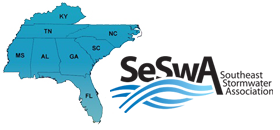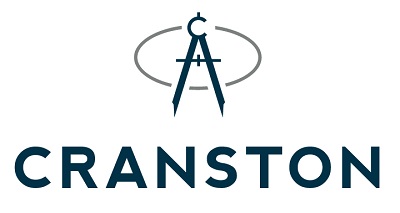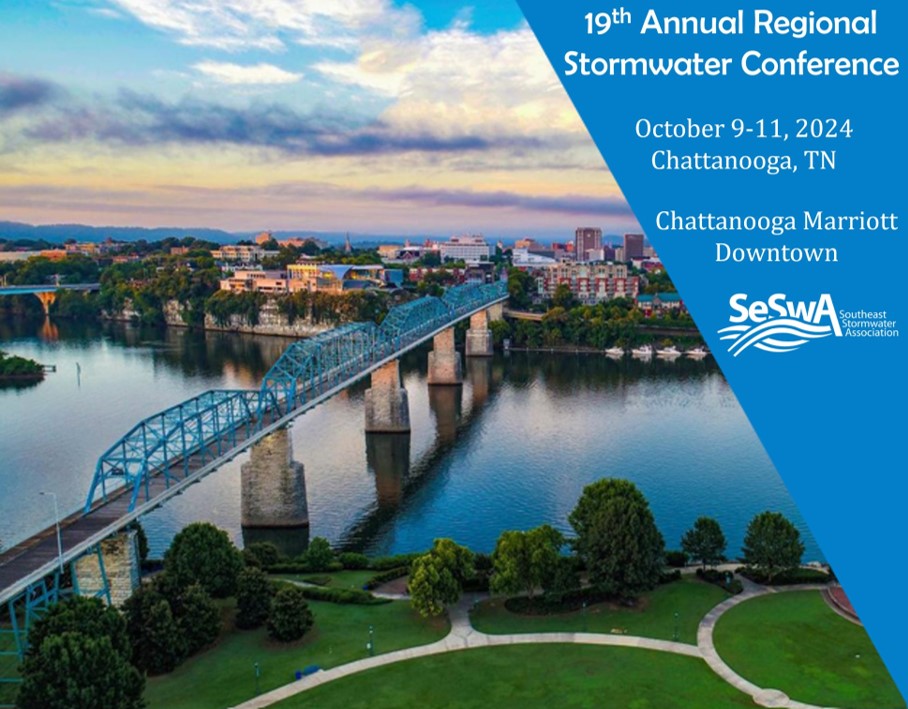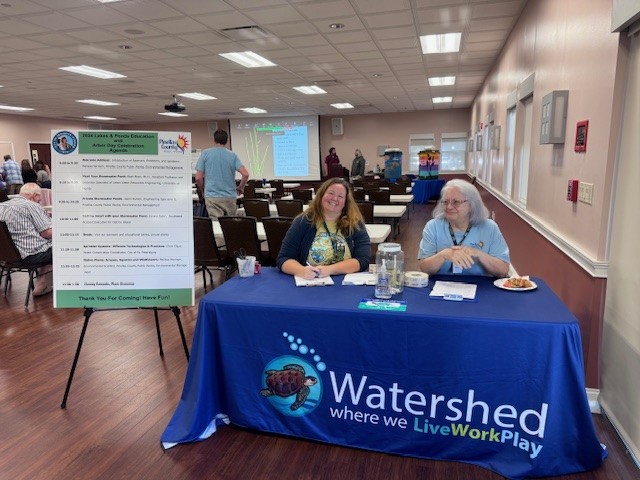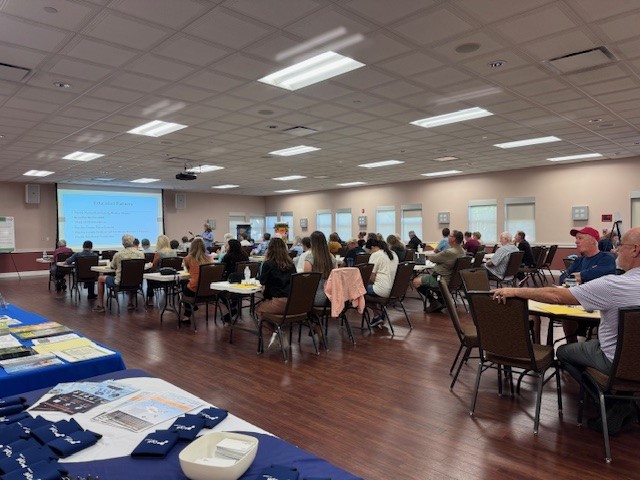- Home
- About Us
- Resources
- Events
- Members Only
- Contact Us
- Join Now
May 2024, Volume 19, Issue 3
TABLE OF CONTENTS
President's Corner
It is Springtime again, time for vacation planning, graduations, and allergy medicine! Some people take the opportunity to do some spring cleaning around the house and/or office. How about we do some “spring cleaning” related to our work? I am not suggesting throwing out a project you are working on, but maybe we take time to “freshen up” our perspective on work-life balance. Dave Canaan |
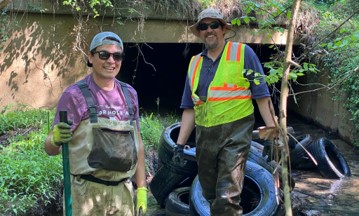 Cory Rayburn and John Butler |
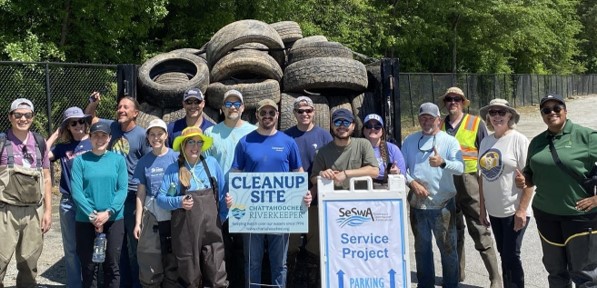 SESWA Volunteers and 83 tires |
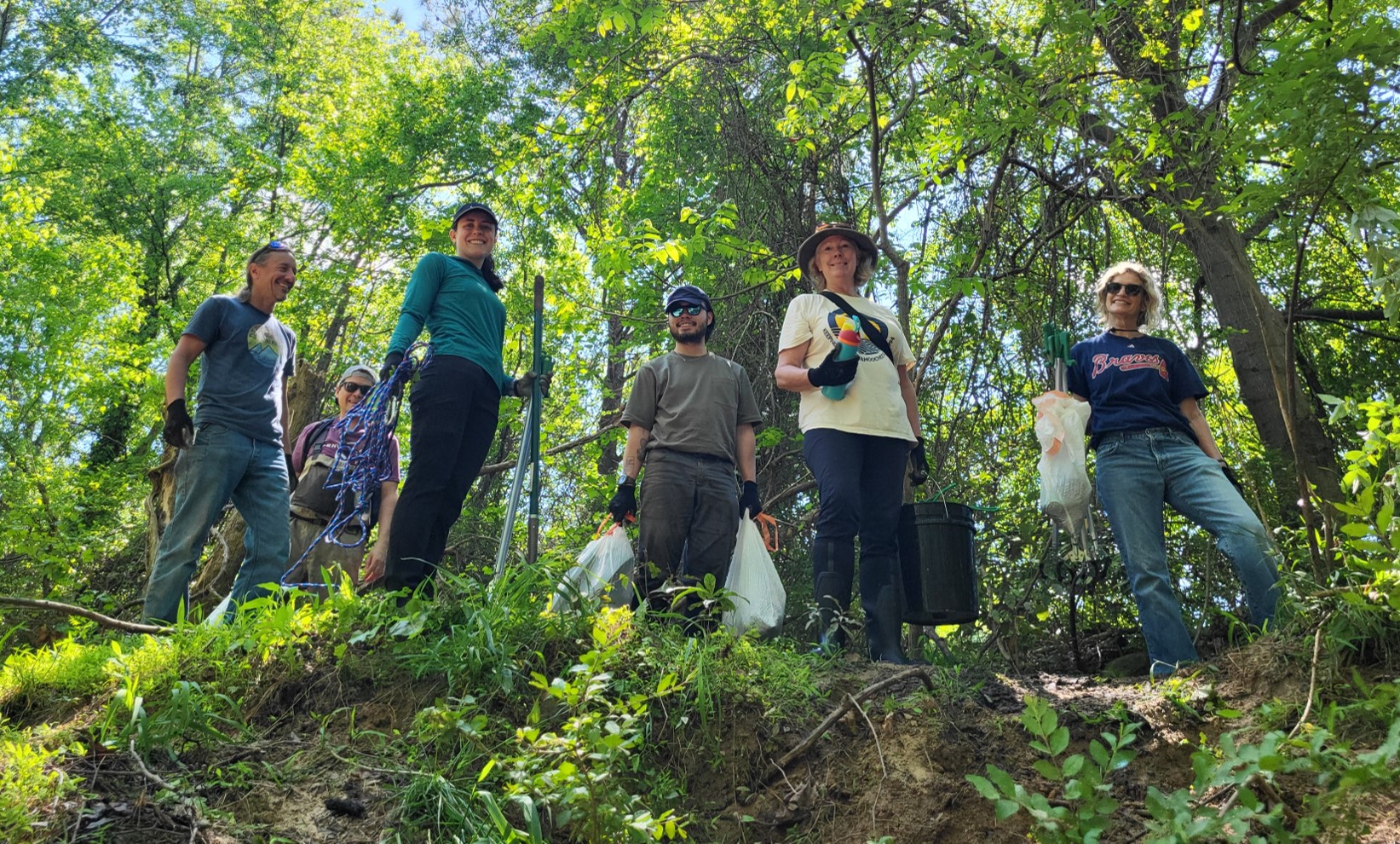 SESWA Volunteers |
Spotlight Webinar – There is still time!
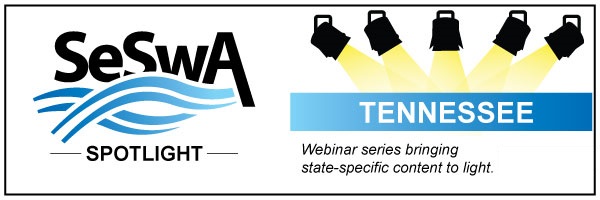 Did you miss SESWA’s Spotlight Webinar Progressing Towards Stormwater Asset Management? Participants heard about the City of Knoxville, Tennessee’s journey to conduct an inventory of over 25,000 structures to update their stormwater asset inventory and transition to an asset management program. It’s not too late to take advantage of this free member benefit. SESWA members can view the webinar presentation and recording online at no cost!
Did you miss SESWA’s Spotlight Webinar Progressing Towards Stormwater Asset Management? Participants heard about the City of Knoxville, Tennessee’s journey to conduct an inventory of over 25,000 structures to update their stormwater asset inventory and transition to an asset management program. It’s not too late to take advantage of this free member benefit. SESWA members can view the webinar presentation and recording online at no cost!
July Webinar – From Better Stormwater Management to Greater Sustainability
Registration is open for SESWA’s next FREE Webinar. The webinar will focus on how improved stormwater management can lead to greater sustainability! Environmental sustainability may conjure images of electric vehicles and paper straws, but better management of urban stormwater should be a key part of each city’s efforts to adapt to and mitigate environmental change. This webinar will cover how one local government’s stormwater program is contributing to the City’s sustainability goal of fostering a green economy and how other stormwater programs can unlock resources and support by tapping into their municipality’s sustainability efforts. The webinar will be free to SESWA members, thanks to our 2024-2025 Communications Sponsors.
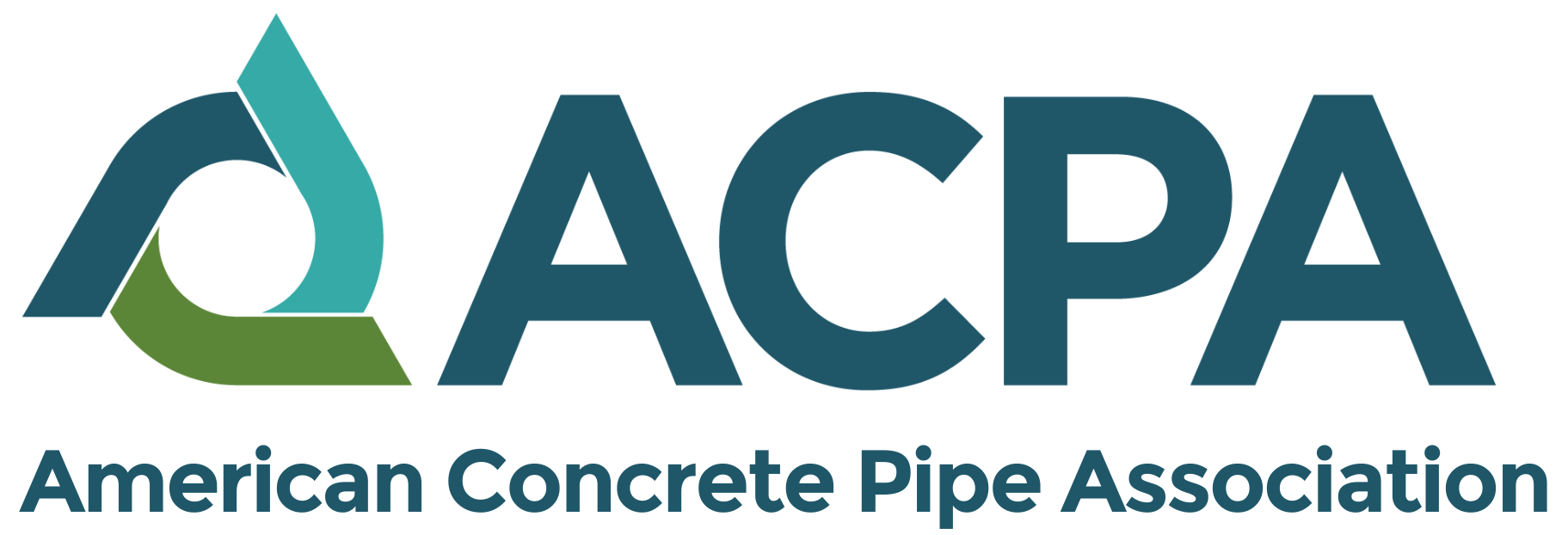 |
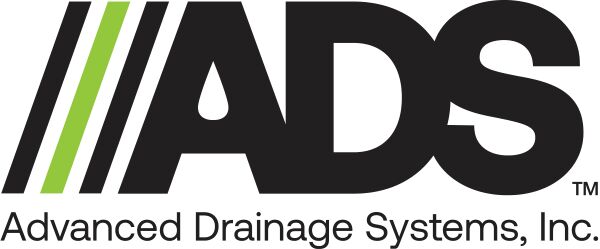 |
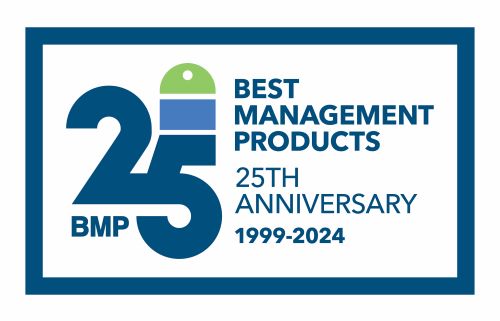 |
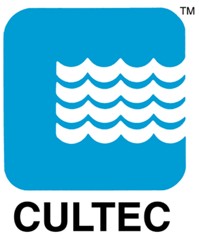 |
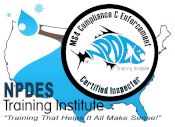 |
SESWA Community Forum – Join the Conversation
SESWA is committed to being a trusted resource and maintaining open channels of communication. As a member of SESWA you have access to an online Forum to post questions, share information, and discuss emerging issues with your peers throughout the Southeast! Here's the latest from the Forum:
New Public Education Ideas to Meet Permit Requirement
Beth Parmer, Clayton County Water Authority, GA
In Clayton County, Georgia, we are getting ready to re-write our 5-year Stormwater Management Plans to meet the new phase I permit requirements. As part of our SWMPs, we are interested in changing up our public education and outreach activities. Read more...
Stormwater Program Budgets
Katie Cromwell, Raftelis
With budget season getting close to wrapping up in many places, how much is your stormwater budget increasing (or not!) next fiscal year and how is the increase being funded (stormwater utility fees, general fund, etc.)? Read more...
Coastal Resiliency
Zorana Kojic, OptiRTC
What is your biggest interest in climate-resilient strategies when managing stormwater? Read more...
Regional WOTUS News
Kevin Coyne, SESWA
Challenges to the Waters of the United States (WOTUS) continue, as EPA pushed to have a case in North Carolina dismissed, claiming the plaintiff is already in an enforcement hearing associated with unpermitted pollution discharges into a wetland. The basis for this dismissal is that the current enforcement case will cover the numerous issues, including WOTUS, being argued by the plaintiff, and an additional case is not necessary. EPA filed a motion on this issue on May 7th and SESWA will continue to watch this case as the motions are reviewed and decided upon.
EPA Stormwater Planning Guidance Materials
Kevin Coyne, SESWA
Many members in the region are tackling the daunting task of infrastructure assessment and management while working to address stormwater and wastewater needs. The EPA, working with stakeholders nationwide, has developed guidance on how to approach and develop shared management that includes stormwater. View the new Stormwater Planning guidance and educational materials on the EPA website. The guidance documents focus on planning and stormwater asset management, outreach to the public and local officials, and examples to see how the process works. EPA also includes a set of worksheets that can be utilized in the planning process. All the worksheets are downloadable and provide helpful step by step processes for the user. As members throughout the region work on any management approach, consider this another tool to help assist with any asset or infrastructure planning method that includes stormwater.
The Big Breakup – South Carolina's DHEC Splitting Up
Lisa Wells, W.K. Dickson
On May 19, 2023 South Carolina’s Governor McMaster signed SB 399 - the 'divorce decree' for separation of the public health and environmental arms of South Carolina Department of Health and Environmental Control (SCDHEC). This act, effective July 1, 2024, dissolves SCDHEC and its Board and creates two cabinet agencies that will be known as the Department of Public Health and the Department of Environmental Services.
Per a presentation by Jill Stewart, SCDHEC Director of Dam Safety and Stormwater Permitting, the idea behind the change is the desire to “right size” South Carolina's environmental programs and modernize the business of environmental protection. The goal is to deliver better and more efficient services and ensure “sustainable” funding in part by maintaining delegation of EPA programs.
The new Department of Environmental Services (DES) will have the same environmental programs they were operating as SCDHEC in addition to bringing over South Carolina Department of Natural Resources (SCDNR) Water Resource Planning & Aquatic Nuisance Species programs. DES will be supported by 152 operations staff (HR, IT, Finance, OGC) with approximately 1,200 total staff delivering services.
The Department of Administration is tasked with ensuring a fair and equitable separation. In addition to the breakup, a few other organizational changes have been incorporated. There will be a continued focus on health services consolidation.
Walk the Talk – Getting Staff to Volunteer
John Butler, Gwinnett County, GA
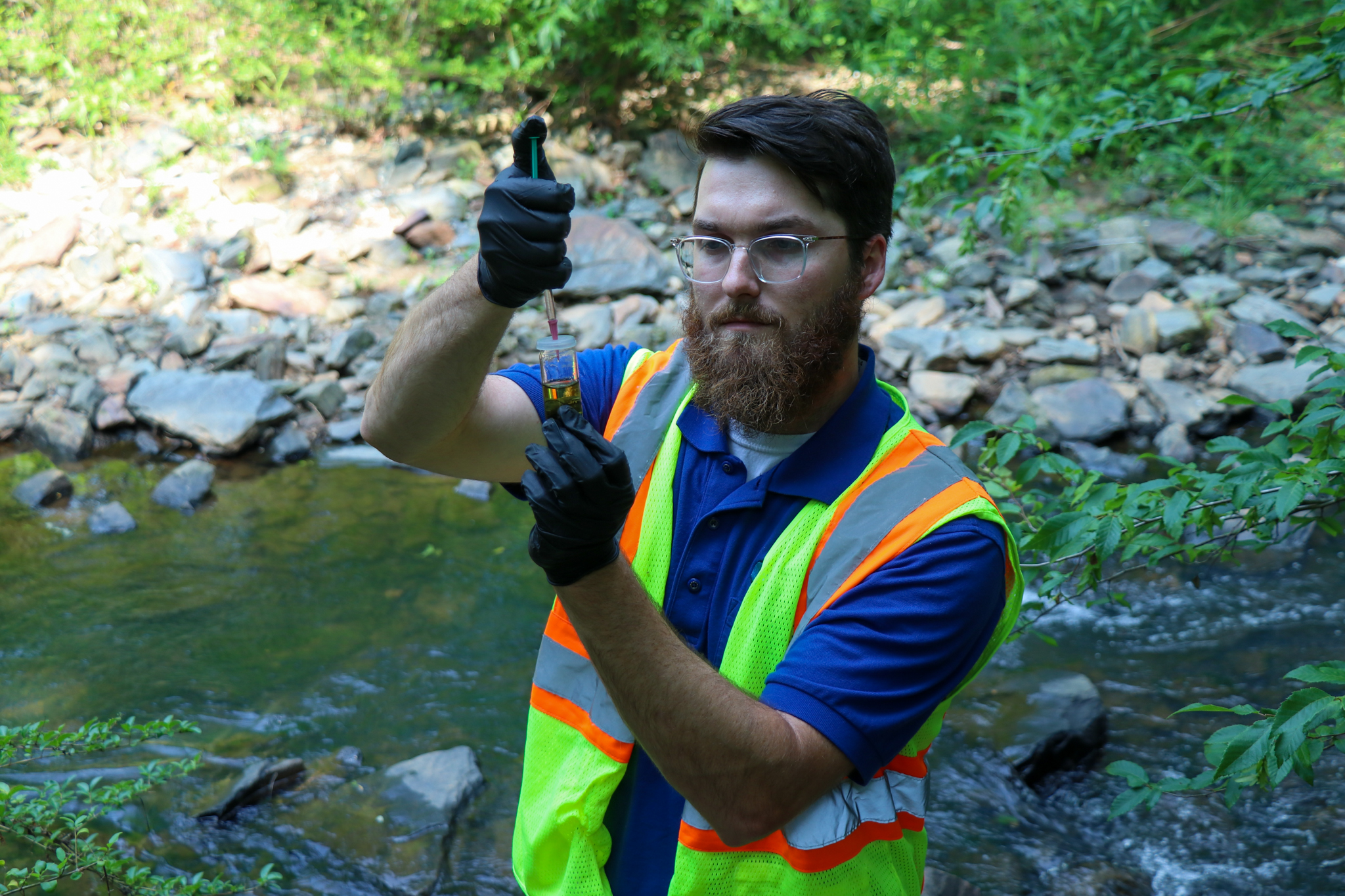 It’s one thing to talk about water quality and stormwater protection, but it’s another to actually go out and do something about it! Some of us are actively engaged in hands-on, boots on the ground action that protects our waterways, but for others our impact can be sort of indirect. Computer work, meetings, planning, designing are all a part of the stormwater process, but it can keep us from making that real connection with our goals.
It’s one thing to talk about water quality and stormwater protection, but it’s another to actually go out and do something about it! Some of us are actively engaged in hands-on, boots on the ground action that protects our waterways, but for others our impact can be sort of indirect. Computer work, meetings, planning, designing are all a part of the stormwater process, but it can keep us from making that real connection with our goals. 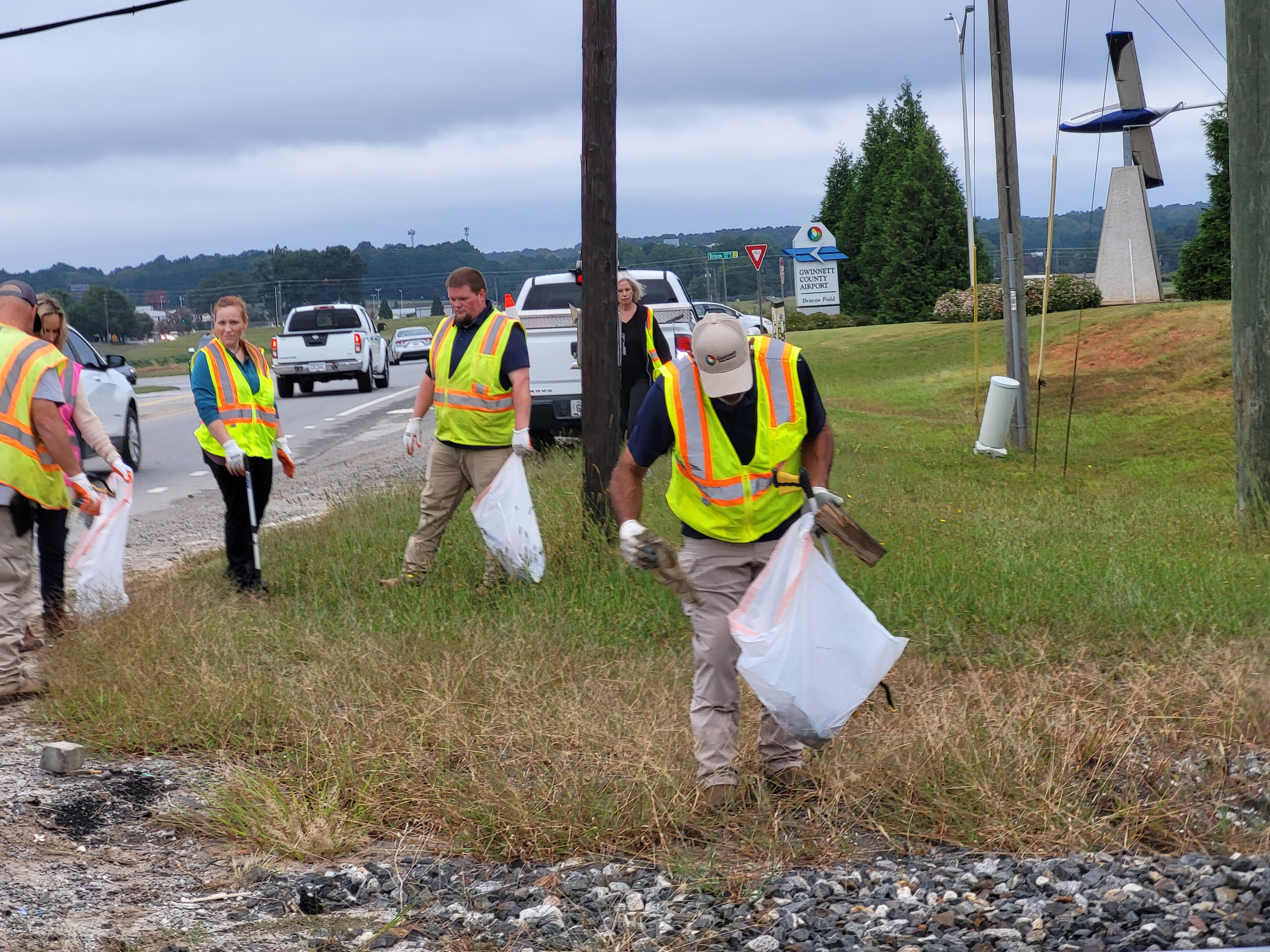 Pulling a tire out of a stream is much different than talking about pulling a tire out a stream. This is where volunteer events for staff can make a huge impact. Think about ways to get your staff out in the field for some action. Adopt-a-Road and Adopt-a-Stream are great programs to get staff engaged in. Stream cleanups and storm drain marking are other options to get your staff off their computers and into the streams. With support from your leadership, these events can even happen during the workday to provide much deserved breaks. It will also generate great stories, new friends, and even boost office morale. Share your employee volunteer project ideas on the SESWA Community Forum.
Pulling a tire out of a stream is much different than talking about pulling a tire out a stream. This is where volunteer events for staff can make a huge impact. Think about ways to get your staff out in the field for some action. Adopt-a-Road and Adopt-a-Stream are great programs to get staff engaged in. Stream cleanups and storm drain marking are other options to get your staff off their computers and into the streams. With support from your leadership, these events can even happen during the workday to provide much deserved breaks. It will also generate great stories, new friends, and even boost office morale. Share your employee volunteer project ideas on the SESWA Community Forum.
Back to the top
How to Evaluate Messaging to Improve and Refresh Your Public Outreach
Julie Berbiglia, Davidson County/City of Nashville, TN
Over time, messaging can get stale, miss the mark, or become ineffective. Collecting data from your audience and using it to adjust your messaging will keep your outreach relevant. Last year, we used a paper-and-pen poll (see example) taped to the table at outreach booths and asked people to indicate how informed they felt about sources of runoff pollution, managing runoff, and stream cleanup volunteering – common messages we have used at our booths for years. The data informed us that 73% of booth visitors were not well-informed on how to report stormwater pollution and 63% were not well-informed about managing runoff. On the other hand, 77% were well-informed about leaking cars causing pollution and 69% were well-informed about lawn chemicals as pollution sources.
Based on this data, we revamped our materials to include ways to report water pollution with a QR code sign, and a phone number and website printed on our tent. The data reinforced our strategy to promote Tennessee Smart Yards, a certification program that emphasizes runoff management. This simple method can yield usable data in one outing. According to Lipscomb University Professor Emily Jones, only 32 data points are needed for statistically significant results.
Back to the top
Lakes & Ponds Education Day: A Successful Community Event Ensures a Knowledgeable Public
Zorana Kojic, OptiRTC
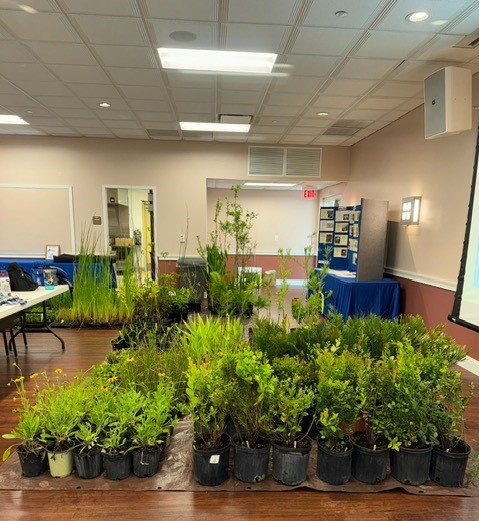 An informed community is crucial to the success of a stormwater management program as it ensures greater support and compliance. Pinellas County, FL has held the Lakes & Ponds Education Day for over a decade and this year was particularly successful as there were both in-person and online attendance options. The focus of the event was for the public to learn about their stormwater ponds’ management and maintenance by using BMPs, new technologies, and local non-profit organizations as resources. There were over 65 people at the City of Seminole facility for the in-person event and over 20 people online. Pinellas County has 24 municipalities and 20 of those were represented through the public in attendance. The event included five presenters, local organizations, and a native plant give-away. University of Florida (UF) faculty introduced the basics of stormwater management. Pinellas County, FL staff covered local regulation and enforcement as well as “right plant right place” for pond vegetation. The City of St. Petersburg, FL staff discussed efficient technologies and practices for home irrigation systems. Presentations were provided to introduce the public to smart stormwater infrastructure as well as resources available such as the Stormwater Pond initiative from the University of Florida’s Institute of Food and Agricultural Sciences (UF IFAS). The plant giveaway was the most fun for all as residents were able to apply their knowledge to select the right plant to create better outcomes in their neighborhood stormwater ponds.
An informed community is crucial to the success of a stormwater management program as it ensures greater support and compliance. Pinellas County, FL has held the Lakes & Ponds Education Day for over a decade and this year was particularly successful as there were both in-person and online attendance options. The focus of the event was for the public to learn about their stormwater ponds’ management and maintenance by using BMPs, new technologies, and local non-profit organizations as resources. There were over 65 people at the City of Seminole facility for the in-person event and over 20 people online. Pinellas County has 24 municipalities and 20 of those were represented through the public in attendance. The event included five presenters, local organizations, and a native plant give-away. University of Florida (UF) faculty introduced the basics of stormwater management. Pinellas County, FL staff covered local regulation and enforcement as well as “right plant right place” for pond vegetation. The City of St. Petersburg, FL staff discussed efficient technologies and practices for home irrigation systems. Presentations were provided to introduce the public to smart stormwater infrastructure as well as resources available such as the Stormwater Pond initiative from the University of Florida’s Institute of Food and Agricultural Sciences (UF IFAS). The plant giveaway was the most fun for all as residents were able to apply their knowledge to select the right plant to create better outcomes in their neighborhood stormwater ponds.
Alluvial Decoder – A Floodplain Creative Education Installation
Ariel Bushel, City of Raleigh, NC
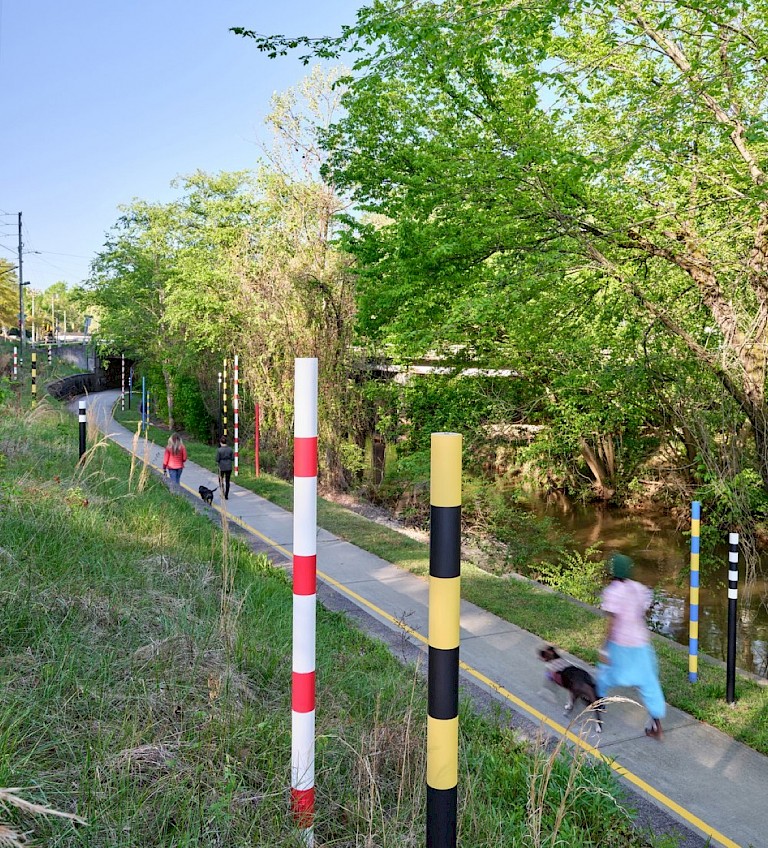 In 2022, the City of Raleigh, North Carolina’s Stormwater department partnered with A Gang of Three, local research-based artists, and Raleigh Arts to design and install an educational installation that brings awareness to the Crabtree Creek floodplain. Crabtree Creek floods frequently during storm events and has a popular trail used by Raleigh residents.
In 2022, the City of Raleigh, North Carolina’s Stormwater department partnered with A Gang of Three, local research-based artists, and Raleigh Arts to design and install an educational installation that brings awareness to the Crabtree Creek floodplain. Crabtree Creek floods frequently during storm events and has a popular trail used by Raleigh residents.
Alluvium is the sediment left in the areas around a water source after a flood. This is an essential part of the floodplain. Decoder references the fact that the project helps people understand more about the floodplain. Flood markers along the train show how high creek water has gotten during tropical storms and hurricanes in Raleigh throughout the years. Since the installation, the Alluvial Decoder has sparked interests in residents about climate, flood awareness, stormwater runoff, pollution prevention, and more. The display shows how public art can encourage conversations surrounding climate issues and water quality. Connecting research, art, and story-telling bridges the gap for communicating meaningful information to the public. The Alluvial Decoder has received local and national recognition. It is one of two North American installations recently highlighted by the Institute for Public Art and is nominated for the International Award for Public Art 2024. Watch a presentation about the process and installation of the Alluvial Decoder.
Since the installation, the Alluvial Decoder has sparked interests in residents about climate, flood awareness, stormwater runoff, pollution prevention, and more. The display shows how public art can encourage conversations surrounding climate issues and water quality. Connecting research, art, and story-telling bridges the gap for communicating meaningful information to the public. The Alluvial Decoder has received local and national recognition. It is one of two North American installations recently highlighted by the Institute for Public Art and is nominated for the International Award for Public Art 2024. Watch a presentation about the process and installation of the Alluvial Decoder.
Back to the top
Florida Phase I MS4 Permit Template Revisions
Nico Pisarello, Geosyntec
The Florida Department of Environmental Protection (FDEP) introduced a series of revisions to the existing template for Phase I MS4 permits. The original proposal was made in 2021 and some key changes included: the restructuring of the template to remove redundancies and streamline the application process, new requirements for inventorying and inspecting non-major outfalls, an evaluation program for inlets and catch basins, updates to training requirements, changes to inspection frequencies for various stormwater assets, and new TMDL implementation criteria. A new annual report form was also developed to accommodate the proposed changes to the permit template.
There was significant concern that if adopted, many of these proposed changes would have a significant impact on Phase I MS4 permittees' financial and staffing resources. A draft version of the new permit template was released in January of 2024 after processing comments and other input from stakeholders (e.g., permittees, public interest groups, etc.) and the United States Environmental Protection Agency (EPA). FDEP intends to begin issuing draft permits using the new permit template before the end of 2024.
Back to the top
NACWA Corner
Provided by the National Association of Clean Water Agencies
Matthew McKenna, Director, Government Affairs
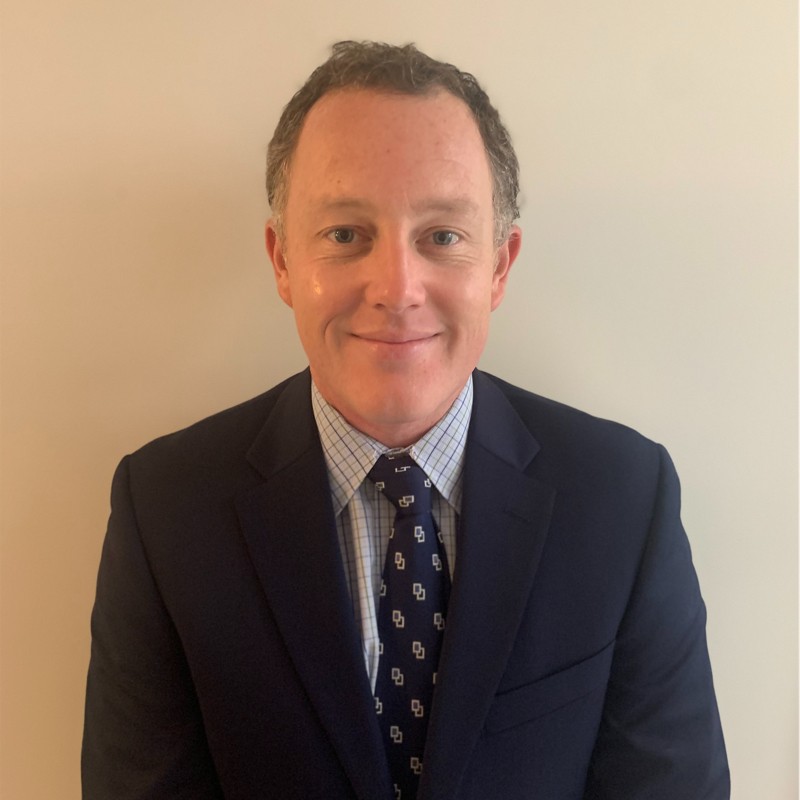 EPA Designates PFOA, PFOS As Hazardous Substances: Future Impacts to Water Sector Ahead
EPA Designates PFOA, PFOS As Hazardous Substances: Future Impacts to Water Sector Ahead
The U.S. Environmental Protection Agency (EPA) formally designated PFOA and PFOS as hazardous substances under the Comprehensive Environmental Response, Compensation and Liability Act (CERCLA). This action marks the first time that EPA is directly designating chemicals as hazardous substances under CERCLA without those substances first being designated as hazardous or toxic under the primary federal air, water, or toxics statutes – which is the usual regulatory course. The rule will go into effect on July 8.
EPA also issued an Enforcement Discretion and Settlement Policy memo noting that “EPA does not intend to pursue entities where equitable factors do not support seeking response actions or costs under CERCLA, including, …publicly owned treatment works, municipal separate storm sewer systems, … and farms where biosolids are applied to land.” This discretionary policy memo, released simultaneously with the notice of the final rule, provides a critical acknowledgement for wastewater and stormwater utilities, but it is unfortunately not legally binding, nor does it protect against third party litigation.
The CERCLA designations for PFOA and PFOS were finalized without any statutory liability protections for passive receivers and these chemicals continue to be manufactured and placed into commerce. The designations will likely bring in public wastewater and stormwater agencies to extensive and costly litigation and liability from third party lawsuits seeking to spread out the significant costs related to PFAS remediation.
NACWA’s attention, which could use the additional help from SESWA members, is to remain steadfast in our Congressional advocacy to secure the water sector with the much needed statutory protections from CERCLA liability. There is progress, with NACWA Board Member Michael Witt testifying at a hearing of the Senate Environment and Public Works Committee.
There is also bipartisan legislation that provides the essential liability protections for water systems, including stormwater, introduced into the House recently that builds Senate’s work from 2023.The protections needed on the CERCLA front, will need all hands on deck, and NACWA’s consistent efforts to leverage its regulatory, legislative, and legal advocacy to carve out PFAS protections for water systems both at EPA and on Capitol Hill continue to see noticeable gains and will continue to be a major priority for the Association and its members. Please contact Matthew McKenna, NACWA’s Director of Government Affairs with questions.
Don't see news from your state?
Please contact us with your news or share your comments on our newsletter by emailing us at [email protected].
